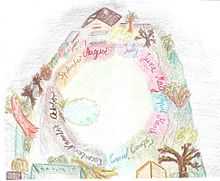Ideasthesia

Ideasthesia (alternative spelling ideaesthesia) is defined as a phenomenon in which activations of concepts (inducers) evoke perception-like experiences (concurrents). The name comes from the Greek idea and aisthesis, meaning "sensing concepts" or "sensing ideas".[1] The main reason for introducing the notion of ideaesthesia was the empirical evidence indicating that the related term synesthesia (i.e. union of senses) suggests incorrect explanation of a set of phenomena traditionally covered by this heading. “Syn”+”aesthesis” denoting “co-perceiving”, implies the association of two sensory elements with little connection to the cognitive level. However, most phenomena that have inadvertently been linked to synesthesia, in fact are induced by the semantic representations i.e., the meaning, of the stimulus [2][3][4][5] rather than by its sensory properties, as would be implied by the term synesthesia. The following table shows the difference in the properties of inducers and concurrents implied by the terms synesthesia and ideasthesia:
| Inducer | Concurrent | |
|---|---|---|
| Synesthesia | Sensory | Sensory |
| Ideasthesia | Semantic | Sensory |
Examples and evidence

Evidence for grapheme-color ideasthesia comes also from the finding that colors can be flexibly associated to graphemes, as new meanings become assigned to those graphemes. In one study synesthetes were presented with Glagolitic letters that they have never seen before, and the meaning was acquired through a short writing exercise. The Glagolitic graphemes inherited the colors of the corresponding Latin graphemes as soon as the Glagolitic graphemes acquired the new meaning.[3]
In another study, synesthetes were prompted to form novel synesthetic associations to graphemes never seen before. Synesthetes created those associations within minutes or seconds - which was time too short to account for creation of new physical connections between color representation and grapheme representation areas in the brain,[6] pointing again towards ideasthesia.
For lexical-gustatory synesthesia evidence also points towards ideasthesia: In lexical-gustatory synesthesia, verbalisation of the stimulus is not necessary for the experience of concurrents. Instead, it is sufficient to activate the concept.[4]
Another case of ideasthesia is swimming-style synesthesia in which each swimming style is associated with a vivid experience of a color.[5] These synesthetes (ideasthetes) do not need to perform the actual movements of a corresponding swimming style. To activate the concurrent experiences, it is sufficient to activate the concept of a swimming style (e.g., by presenting a photograph of a swimmer or simply talking about swimming).
Ideasthesia in normal perception

References
- ↑ Nikolić, D. (2009) Is synaesthesia actually ideaesthesia? An inquiry into the nature of the phenomenon. Proceedings of the Third International Congress on Synaesthesia, Science & Art, Granada, Spain, April 26–29, 2009.
- ↑ 2.0 2.1 Dixon, M.J., Smilek, D., Duffy, P.L., Zanna, P. M., Merikle, P. M. (2006) The Role of Meaning in Grapheme-Colour Synaesthesia, Cortex 42: 243-252.
- ↑ 3.0 3.1 Mroczko A., T. Metzinger, W. Singer, D. Nikolić (2009) Immediate transfer of synesthesia to a novel inducer. Journal of Vision, 9: 2521-2528.
- ↑ 4.0 4.1 Simner, J.; Ward, J. (2006) The taste of words on the tip of the tongue, Nature 444: 438.
- ↑ 5.0 5.1 Nikolić, D., U.M. Jürgens, N. Rothen, B. Meier, A. Mroczko (2011) Swimming-style synesthesia. Cortex, 47(7):874-879.
- ↑ Jürgens U.M., Nikolić D. (2012) Ideaesthesia: Conceptual processes assign similar colours to similar shapes. Translational Neuroscience, 3(1): 22-27.
- ↑ Gómez Milán, E., Iborra, O., de Córdoba, M.J., Juárez-Ramos V., Rodríguez Artacho, M.A., Rubio, J.L. (2013) The Kiki-Bouba effect: A case of personification and ideaesthesia. The Journal of Consciousness Studies. 20(1-2): pp. 84-102.
External links
- Swimming-style synesthesia described by New Scientist
- More than crossed senses
- More information on ideasthesia on the web site of Danko Nikolić.
- Audio Criticism & Ideasthesia